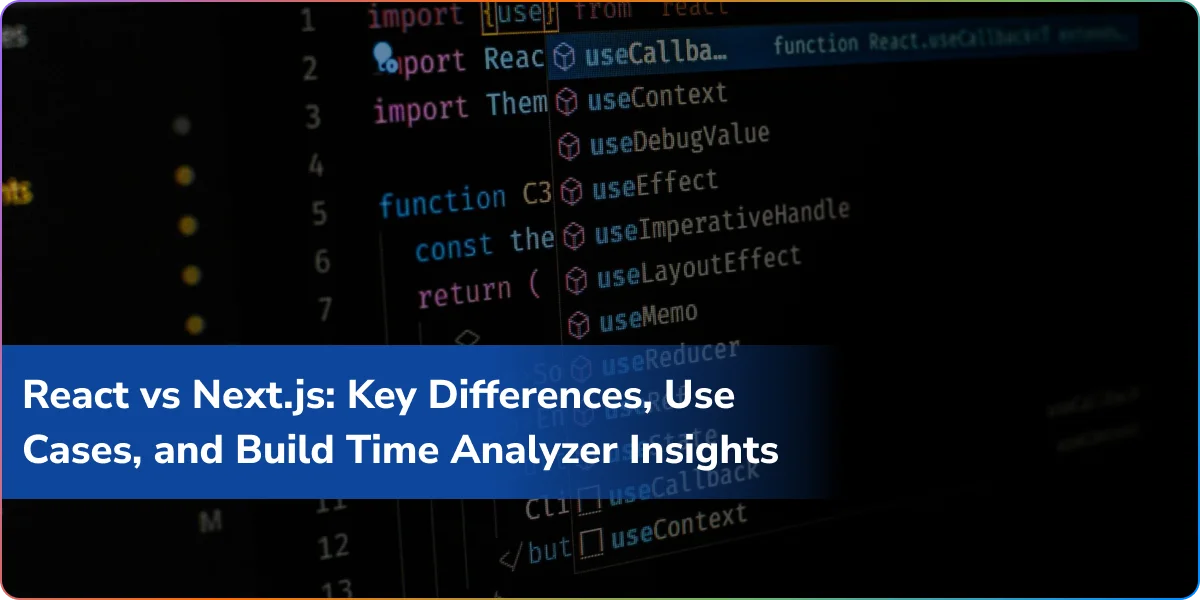In the modern digital-first world, it takes the right JavaScript tools to build high-performance web applications. Whether you’re creating a single-page application (SPA), a progressive web app (PWA), or an enterprise-class solution, having the proper web app framework JavaScript can either make or ruin your project. With there being so many libraries and JS frameworks out there, it gets too hard to choose which one to use.
To guide you in making an effective decision, here’s an exhaustive list of the most popular JavaScript frameworks that are taking the market by storm. These in-demand JS frameworks are selected based on performance, scalability, community support, and user-friendliness.
1. React.js
Created by Facebook, React.js is perhaps the top JavaScript framework (technically a library) for constructing user interfaces. It’s extremely popular for SPAs and mobile app development via React Native.
Major Features:
- High-performance Virtual DOM
- Component-based architecture
- Dense community and lush ecosystem
- Supported by Meta (Facebook)
React remains at the top among the most widely used JavaScript frameworks due to its flexibility and the rich availability of reusable components.
2. Vue.js
Vue.js is among the popular JS frameworks, particularly in startups and independent developers. It is user-friendly with a soft learning curve, making it a favorite among beginners.
Main Features:
- Lightweight and efficient
- Two-way data binding
- Very detailed documentation
- Reactive data binding
If ease of use and performance are balanced, Vue.js is one of the top JavaScript frameworks to begin with.
3. Angular
Maintained by Google, Angular is a full-web app framework JavaScript for enterprise-level apps. It utilizes TypeScript, which provides a layer of type safety and OOP capabilities for JavaScript.
Major Features:
- Integrated dependency injection
- Two-way data binding
- Advanced CLI
- Scalable for large apps
Angular is one of the most used JavaScript frameworks for developing scalable and dynamic web apps that need strong features and structure.
4. Next.js
Next.js is a JS framework based on React that is specifically geared for developing server-side rendered (SSR) apps and static websites. It is particularly well-known for making SEO-friendly applications.
Key Features:
- File-based routing
- Static site generation (SSG) and SSR
- Built-in API routes
- Image optimization
Next.js is practically regarded as the best JS framework for business-grade websites that require both performance and SEO advantages.
5. Svelte
Svelte takes a revolutionary new approach by compiling components at build time instead of executing them in the browser. It’s a light, speedy, and developer-happy JavaScript tool.
Main Features:
- No virtual DOM
- Genuinely reactive programming
- Smaller bundle sizes
- Simple to learn and use
As a more recent addition to popular JS frameworks, Svelte is gaining fast momentum for its performance and simplicity.
6. Express.js
Express.js is a back-end web application framework that runs on Node.js and is not a front-end JavaScript framework. It’s critical for creating REST APIs and full-stack web applications.
Important Features:
- Unopinionated and minimalist
- Support for middleware
- High performance
- Direct integration with databases
Express.js is certainly one of the best JavaScript frameworks to learn for developers who are creating server-side apps with JavaScript.
7. Nuxt.js
Nuxt.js is a robust JS framework based on Vue.js. It makes it easier to develop universal or single-page Vue apps with SSR, SSG, and more.
Main Features:
- Automatic routing
- SEO-friendly
- Static site generation
- Vue-based architecture
Nuxt.js is one of the most favored JavaScript frameworks among Vue enthusiasts who wish for more capabilities and better performance optimization.
8. Gatsby.js
Gatsby.js is an open-source, React-based framework used to build fast, SEO-friendly static websites. It fetches data from various sources and builds it into static files during build time.
Major Features:
- Quick page loads
- Plugin-rich ecosystem
- GraphQL integration
- SEO-optimized
Gatsby.js excels in applications such as blogs, portfolios, and documentation sites and is considered a top JS framework for content-heavy sites.
9. Meteor.js
Meteor.js is a full-stack JavaScript framework that allows you to create web and mobile applications solely in JavaScript. It enables real-time communication, which makes it perfect for collaborative applications.
Key Features:
- Full-stack reactivity
- Integrated with MongoDB
- Real-time data sync
- Supports Angular, React, and Blaze
If you prefer to have everything in one bundle, Meteor.js is a great choice among the best JavaScript frameworks.
10. Ember.js
Ember.js is a strongly opinionated JS framework with a convention-over-configuration philosophy. It’s ideal for developers who desire a full-featured framework with reduced decision fatigue.
Main Features:
- Ember CLI
- Integrated router and services
- Two-way data binding
- Stability without stagnation
While not as popular as React or Vue, Ember.js remains one of the top JS frameworks for developing ambitious web apps with minimal configuration.
Why Choosing the Right JS Framework Matters
The right JavaScript framework can make a huge difference in your project timeline, code maintainability, and scalability down the line. The right tool will simplify development, while the wrong one will bring technical debt.
Whether picking from these best JavaScript frameworks for front-end, back-end, or full-stack development, always take:
- Project Requirements: Scalable tools such as Angular or Ember are required for complex applications, whereas basic SPAs can be best accommodated by Vue or Svelte.
- Team Experience: If your developers already have experience with React, utilizing frameworks such as Next.js or Gatsby is a tactical decision.
- Community and Ecosystem: Popularity translates to superior support, more libraries, and regular updates something critical when working with tight deadlines.
Emerging Trends in JavaScript Frameworks (2025 and Beyond)
The JS framework ecosystem keeps changing at a fast pace. Some of the trends to look out for are:
- TypeScript Adoption: Increasing numbers of frameworks are adopting or featuring TypeScript out of the box for type safety and improved tooling.
- Edge Functions & Serverless: Next.js and Nuxt 3 are among the frameworks backing edge computing for improved response times.
- Framework-Agnostic Tools: Tools such as Vite and Turbopack are revolutionizing the build process for various frameworks.
- AI Integration: Better developer tooling with AI (such as GitHub Copilot) is changing the way we use JavaScript tools for coding and testing.
Conclusion: Which is the Best JS Framework for You?
There’s no one-size-fits-all when it comes to selecting the best JS framework. Each of these most popular JavaScript frameworks serves different use cases, project sizes, and developer preferences.
No matter what your development goals are, these popular JS frameworks provide a solid foundation for modern web development. Be sure to evaluate your project’s needs carefully before diving in and always stay updated, as the JavaScript tools ecosystem is constantly evolving.
Want to develop your next web app with the popular JS frameworks? Hire skilled JS developers from Logixbuilt Solutions—a reliable web and app development partner. Our experienced developers are experts in modern JavaScript environments and offer secure, scalable, and lightning-fast solutions tailored to your goals.
FAQ’s
1. What are JS frameworks utilized for?
JS frameworks offer pre-coded libraries and organization for developing strong and scalable web applications efficiently.
2. What are the most popular JavaScript frameworks of 2025?
The most trending JavaScript frameworks of 2025 are React.js, Angular, Vue.js, Svelte, and Next.js.
3. What is the ideal JS framework for beginners?
Vue.js and React.js are the ideal JS frameworks for beginners because they are easy to learn and have a massive community support.
4. What JS framework is ideal for SEO?
Next.js and Nuxt.js provide great SEO features through server-side rendering and static site generation.
5. Can I use more than one JS framework in a single project?
Although technically allowed, using more than one JS framework within the same project is not typically advised for reasons of complexity and the possibility of conflict.



